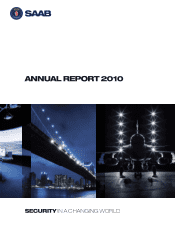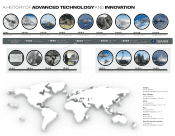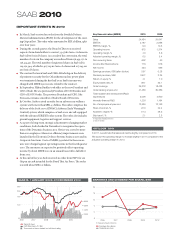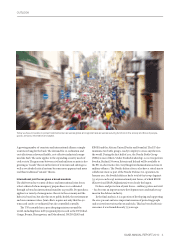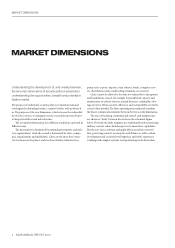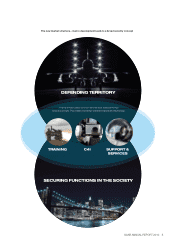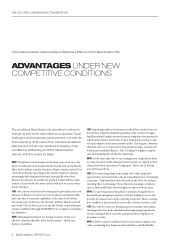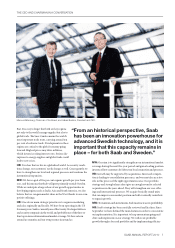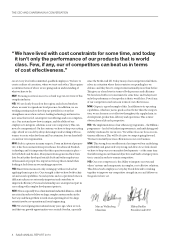Saab 2010 Annual Report Download - page 10
Download and view the complete annual report
Please find page 10 of the 2010 Saab annual report below. You can navigate through the pages in the report by either clicking on the pages listed below, or by using the keyword search tool below to find specific information within the annual report.
East. It is easy to forget that both are key regions
not only to the world’s energy supplies but also to
global trade. e Suez Canal remains the world’s
most important trade route, carrying around ten
per cent of seaborne trade. Developments in these
regions are critical to the global economy going
forward. High oil prices may drive ination,
which in turn is raising interest rates. Serious dis-
ruptions to energy supplies and global trade could
lead to new crises.
HB: It is clear that we live in a globalized world. As security condi-
tions change, our customers’ needs change as well. Consequently, we
have to strengthen our local and regional presence and continue the
international expansion.
MW: We have a goal of ve per cent organic growth per year from
, and this means that Saab will grow primarily outside Sweden.
While we anticipate a larger share of our growth opportunities in
developing regions such as India, Asia and South America, we also
believe that we can gain market share in the West thanks to our com-
petitive oerings.
HB: One of our main strategic priorities is to organise marketing
and sales regionally and locally. We have been operating in the US
for many years. Saab is currently one of the twenty-ve largest defence
and security companies in the world, and probably one of the three or
four top in terms of international market coverage. We have sales in
around countries and our own presence in around .
MW: Our aim is to signicantly strengthen our international market
coverage during the next ve-year period and gain a leading position
in terms of how customers feel about our local connection and presence.
HB: Growth may be supported by acquisitions. Increased competi-
tion is leading to consolidation pressures, and we may take an active
role in this process if the right opportunities arise. Our portfolio
strategy and strong balance sheet give us enough room for selected
acquisitions in the years ahead. ey will strengthen our core oer-
ings and international presence. We acquire basically sound units
that can improve our market position and will eventually contribute
to organic growth.
MW: To maintain such investments, Saab must increase its protability.
HB: Saab’s strategy has been carefully reviewed and lies rm. Since
September we have dened the main features in order to concentrate
on implementation. It is important to keep momentum going and
drive and implement on our strategy. We will create protable
growth through a focused portfolio and by implementing ecien-
“ From an historical perspective, Saab
has been an innovation powerhouse for
advanced Swedish technology, and it is
important that this capacity remains in
place – for both Saab and Sweden.”
Marcus Wallenberg, Chairman of the Board, and Håkan Buskhe, President and CEO.
SAAB ANNUAL REPORT 2010 7
THE CEO AND CHAIRMAN IN A CONVERSATION

